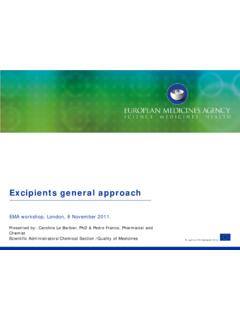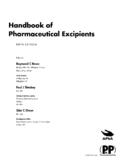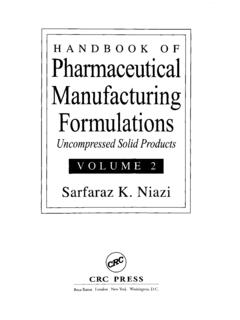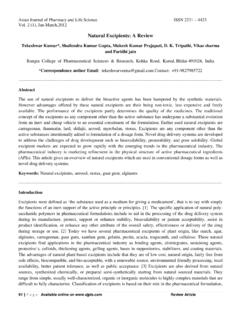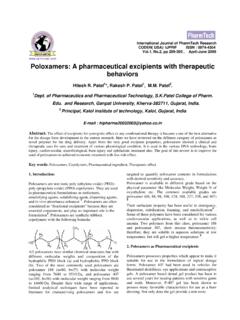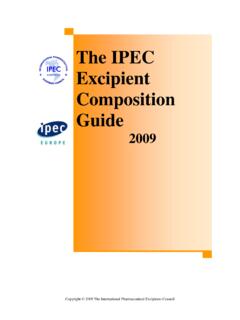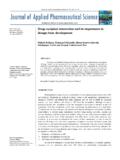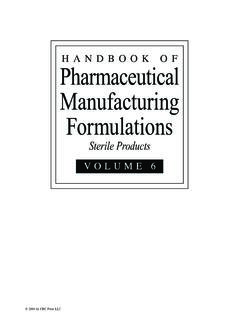Transcription of Compendium of Pharmaceutical Excipients for …
1 Lobal research in Pharmaceutical sciences will acquirenew dimensions in the post-GATT (General Agree-ment in Trade and Tariff ) era. The Pharmaceutical in-dustry currently is focused on the identification anddevelopment of novel leads from areas such as biotechnology,combinatorial chemistry, molecular modeling, and genetic en-gineering. The leads coming from these varied sources will re-quire specialized formulation techniques and ingredients. Atthe same time, the process of discovering new drugs is a costlyproposition and requires input from the basic as well as appliedsciences. Research organizations that do not have adequate ex-pertise or vision tend to fall out rapidly. The alternative ap-proach for such organizations would be to develop new dosageforms or formulations using novel Excipients for the existingdrugs that offer distinct benefits over the conventional formu-lations.
2 Recent developments in Pharmaceutical legislation, reg-ulatory guidelines, and licensing policies have led to increasedawareness of the properties and roles of Excipients in formula-tions. A careful use of Excipients can lead to the development14 Pharmaceutical TechnologyDRUG DELIVERY of Pharmaceutical Excipients for Vaginal FormulationsSanjay Garg,* Kaustubh R. Tambwekar, Kavita Vermani, Alka Garg,Chaman L. Kaul, and Lourens J. D. ZaneveldSanjay Gargis an assistant professor;Kaustubh R. Tambwekaris a PhDscholar; Kavita Vermaniis a PhD scholar;andChaman L. Kaulis director, all at theNational Institute of PharmaceuticalEducation and Research (NIPER), Sector 67, Nagar, Punjab-160062, India, tel. 91 172 214682; fax 91 172 214692, e-mail Alka Gargis a PhD scholar at the University Institute ofPharmaceutical Sciences, Panjab University,Chandigarh-160014, India, and Zaneveldis the director of theProgram for Topical Prevention ofConception and Disease, Rush University,Chicago, IL.
3 *To whom all correspondence should be of an ideal vaginalformulation with desired characteristics interms of safety, efficacy, patient compliance,aesthetics, acceptability to regulatoryauthorities, and cost requires a careful andmeaningful selection of the activeingredients and article listsall presently available vaginal excipientsalong with their functional categories,concentrations (where available), andregulatory overall objective ofthis communication is to aid the formulationscientist in selecting the optimal excipientsfor the preparation of vaginal , TechnologyDRUG DELIVERY 200115of novel delivery systems that are both effective and economi-cal. These innovative formulations also may offer life extensionto drugs in the form of new patents, extending the product lifecycle and adding to the market share of the formulation can be regarded as a system comprising an ac-tive molecule along with some inert ingredients (see Figure 1).
4 According to the definition given by the International Phar-maceutical Excipients Council (IPEC), Excipients are sub-stances, other than the active drug substance or finished dosageform, which have been appropriately evaluated for safety andare included in drug delivery systems for specific functions (1).This definition indicates that Excipients are to render easy pro-cessing of the drug delivery systems, to protect, support, or en-hance stability, bioavailability, and patient compliance. Theyalso assist in product identification and are important for over-all safety and effectiveness of the drug delivery system duringstorage or use. These ingredients render specific properties toa formulation and thus represent an important aspect of for-mulation design and optimization. Selection of the type andamount of excipient is dictated by the target formulation pro-file and is a major challenge for the Pharmaceutical the ingredients of a formulation other thanactive ingredient were known as inactive ingredients.
5 In thepresent day, where these inactive ingredients are known to playa crucial role in designing a formulation and to provide desir-able characteristics, the term excipientis more commonly equivalent ofactivityin an excipient is functionality, whichrefers to special attributes that the ingredient can provide to aformulation. Developing a new excipient is as complicated asdeveloping a new drug molecule; therefore, Excipients manu-facturers tend to opt for an easier route for value-added spe-cialty Excipients . Knowledge and understanding of the ingre-dients are extremely useful to a product development selectionThe choice of an excipient for a particular formulation is gov-erned by various critical parameters spanning from their ori-gin to their regulatory status. These includelorigin, source, and availabilitylfunctional category lquality and puritylimpurity levels and extent of characterization lbatch-to-batch consistencylstability in the pure form and in the formulationlcompatibility with the active ingredient and packaging materiallhistory of prior human uselsafety and toxicological issues lcost considerationslbiological activity(ies), if anylregulatory and compendial status lpatent in vaginal vagina has been exploredas a favourable site for the local and systemic delivery of drugsused for the treatment of female-specific conditions.
6 Vaginaladministration of drugs is mainly used for the treatment of localinfections such as vaginitis, bacterial vaginosis, candidiasis, andother infections. In addition, vaginal formulations have a greatpotential for the systemic absorption of drugs because of thelarge surface area, rich blood supply, and permeability to a widerange of compounds, including peptides and proteins (2). Vagi-nally administered agents and formulations are mainly usedand are being developed to provide protection against micro-bial infections, including Acquired Immune Deficiency Syn-drome (AIDS) and other sexually transmitted diseases. Knownas microbicides, these agents and formulations are also poten-tial vaginal types of formulations are available for intravaginaltherapy. These include tablets, hard and soft gelatin capsules,creams, suppositories, pessaries, foams, ointments, gels, films,tampons, vaginal rings, and douches.
7 Figure 2 lists various vagi-nal dosage forms and the classes of Excipients used in them. Vagi-nal formulations are not only available in modern allopathic sys-tems of medicine but also in traditional systems of medicinesuch as Ayurveda. Depending on the characteristics of the dosageform, Excipients with different functionalities are Excipients present in a vaginal formulation may not beinert and therefore exhibit specific activities, which may affectthe primary activity of the active molecule. Recent studies haveshown that some Excipients possess activities against sexuallytransmitted pathogens. The ingredients normally used as ex-cipients and possessing potent antimicrobial activities includebenzalkonium chloride (3), sodium dodecyl sulfate/sodiumlauryl sulfate (4,5), carrageenan (6,7), cellulose acetate phtha-late (CAP) (8,9), and undecylenic acid (10).
8 At the same time,several agents being developed as active ingredients have thepotential of being used as specialty Excipients based on theirphysicochemical characteristics. Examples of such ingredientsinclude cellulose sulfate (11) and polystyrene sulfonate (12,13).MethodologySelecting appropriate Excipients for vaginal formulations is achallenge to development scientists. This article is an effort tocreate a Compendium of Excipients used (marketed), approved,or investigated for vaginal application. The Excipients used invaginal formulations are relatively less defined in the literatureand in regulatory publications in terms of their specific func-tionalities and toxicities. Information has been compiled fromthe FDA Inactive Ingredient Guide (14), handbook of pharma - ceutical Excipients (15),Physicians Desk Reference(PDR), theInternet, patents, Medline (16), International PharmaceuticalInactiveingredients(excipi ents)ActiveingredientFigure 1:Concept of a TechnologyDRUG DELIVERY I.
9 Details of Excipients present in various vaginal orIndication orProductFormDeveloped byCompositionTherapeutic UseAci-JelJellyOrtho-McNeilGlacial acetic acid, oxyquinoline sulfate, ricinoleic acid,Restoration andPharmaceuticalglycerin, tragacanth, acacia, propyl paraben, potassiummaintenance ofhydroxide, stannous chloride, egg albumin, potassium vaginal aciditybitartarate, perfume, waterAdvantage SBioadhesiveColumbiaWater, glycerin, mineral oil, Polycarbophil, hydrogenated palm oilSpermicidalgelLaboratoriesglyceride, Carbomer 934P, methyl paraben, sorbic acid, NaOHcontraceptiveAmino-cervCreamMilexUre a, sodium propionate, methionine, cystine, inositolCervicitisAVCC ream,MonarchCream: lactose, propylene glycol, stearic acid, diglycol stearate,Vulvovaginitissuppositorymethyl paraben, propyl paraben, trolamine, lactic acidcaused by.
10 Polyethylene glycol 400 and 3350, Polysorbate 80,albicansglycerin, lactic acid, cover made up of gelatin, glycerin, water,methyl paraben, propyl paraben, colorBetadineDouchePurdue Fredrick Vaginal irritationBuffer gel**GelReprotectCarbopol 974 PMaintain vaginal aciditySavvy/C 31 GGelBiosynC 31G (as a 10% concentrate), type A gelatin, purified cornMicrobicidestarch, hydroxypropylmethyl cellulose, glycerine, waterC 31G* SuppositoryBiosynC 31G (as a 10% concentrate), polyethylene glycol 400,Microbicide1450, 3350, 8000 CanestenCreamBayer alcohol, cetyl stearyl alcohol, 1-oatyl dodecanol,Fungal infection,Polysorbate 60, water, sorbitan monostearate, spermacetitrichomoniasisCanestenInsertBa yer acid, colloidal silicon dioxide, lactose, magnesium stearate,Fungal infection,(tablet)maize starch, Polysorbate 80, sodium bicarbonate, stearic acidtrichomoniasisCervidilInsertForest Laboratories Cervical ripeningCleocinCreamPharmacia &Benzyl alcohol, cetostearyl alcohol, cetyl palmitate, mineral oil,BacterialVag-creamUpjohnPolysorbate 60, propylene glycol, sorbitan monostearate, stearic acid vaginosisClotrimazoleCream Sodium phosphate, monobasic, adipic acid, colloidal siliconYeast infectionsdioxide, lactose, magnesium stearate, maize starch,Polysorbate 80, sodium bicarbonate stearic acidConceptrolGelOrtho-McNeilCellulose gum, lactic acid, methyl paraben, povidone,Spermicide, anti-propylene glycol, water, sorbic acid, sorbitol solutionmicrobial, antiviralCortisone-Cream Aloe barbadensis gel, aluminium sulfate, calcium acetate, 10 Pluscetearyl alcohol, cetyl alcohol, corn oil, glycerine.



